Economics Assignment: Schmeckt Gut Demand and Economic Factors
VerifiedAdded on 2021/11/20
|20
|4617
|102
Report
AI Summary
This economics assignment analyzes the factors impacting the demand for Schmeckt Gut, including tariff rates, income growth, and inflation. The report explores the relationship between these independent variables and the dependent variable (demand) using regression analysis. It examines the concepts of aggregate supply and demand, aggregate supply shocks, the Phillips curve, and the Laffer curve to understand the economic environment. The analysis considers the effects of tariffs on import and domestic production, income on demand for different types of goods, and inflation on purchasing power and overall economic performance. Finally, the assignment provides recommendations for the company to enhance its variability and sustainability in a monopolistic market structure. The report includes figures illustrating demand and supply curves, aggregate supply shocks, and the relationship between inflation and unemployment.
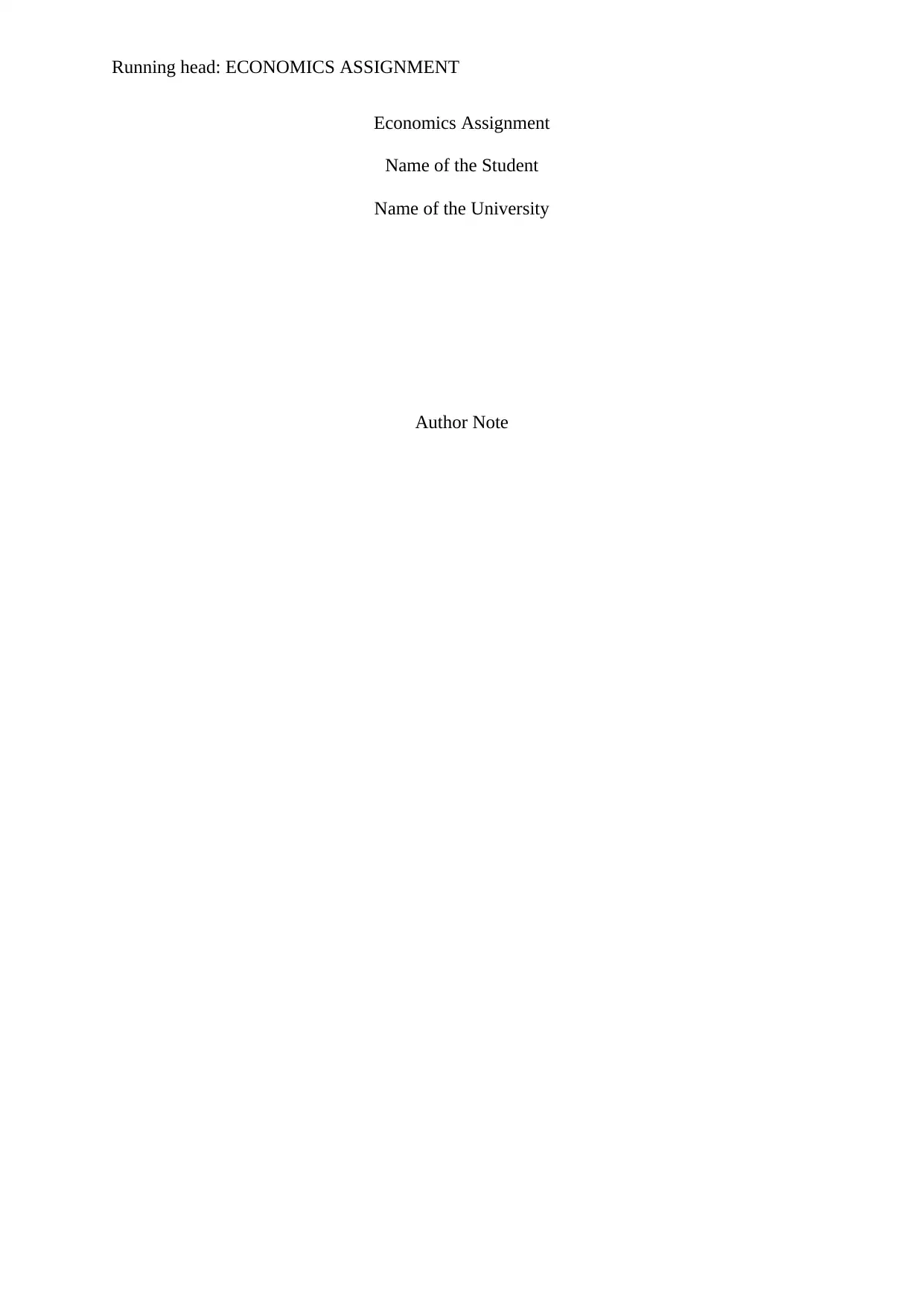
Running head: ECONOMICS ASSIGNMENT
Economics Assignment
Name of the Student
Name of the University
Author Note
Economics Assignment
Name of the Student
Name of the University
Author Note
Paraphrase This Document
Need a fresh take? Get an instant paraphrase of this document with our AI Paraphraser

ECONOMICS ASSIGNMENT1
Executive Summary
For this paper, the factors that will impact the overall demand of Schmeckt Gut will
be thoroughly analyzed and evaluated. The main factors which will be analyzed include
among others; tariff rate growth, income growth and inflation rate growth. Inflation has
various consequences to overall economic performance of firms, households and
Government. Inflation exists in various forms depending on the causes. Also tariffs and
income are important in facilitating the aggregate demand and supply levels in an economy.
Therefore to effectively measure the impact of the independent variables on the dependent
variable, a regression analysis will be undertaken to determine the existing relationships.
Lastly, the paper will draw rational and logical recommendations that can be adopted by the
company to promote its variability and sustainability.
Executive Summary
For this paper, the factors that will impact the overall demand of Schmeckt Gut will
be thoroughly analyzed and evaluated. The main factors which will be analyzed include
among others; tariff rate growth, income growth and inflation rate growth. Inflation has
various consequences to overall economic performance of firms, households and
Government. Inflation exists in various forms depending on the causes. Also tariffs and
income are important in facilitating the aggregate demand and supply levels in an economy.
Therefore to effectively measure the impact of the independent variables on the dependent
variable, a regression analysis will be undertaken to determine the existing relationships.
Lastly, the paper will draw rational and logical recommendations that can be adopted by the
company to promote its variability and sustainability.

ECONOMICS ASSIGNMENT2
Table of Contents
Introduction................................................................................................................................3
Demand and Supply...................................................................................................................3
Demand and Supply and supply curve.......................................................................................4
The aggregate supply/aggregate demand...................................................................................4
Aggregate supply shocks............................................................................................................6
Aggregate supply shocks curve..................................................................................................6
The Phillips curve......................................................................................................................7
The Laffercurve..........................................................................................................................7
SECTION 2................................................................................................................................8
Impacts of Tariff rate growth, Inflation and Yon Schmeckt Gut demand.................................8
Part B........................................................................................................................................10
Regression Analysis.................................................................................................................10
Recommendations....................................................................................................................13
References................................................................................................................................14
Appendix…………………………………………………………………………………….15
Table of Contents
Introduction................................................................................................................................3
Demand and Supply...................................................................................................................3
Demand and Supply and supply curve.......................................................................................4
The aggregate supply/aggregate demand...................................................................................4
Aggregate supply shocks............................................................................................................6
Aggregate supply shocks curve..................................................................................................6
The Phillips curve......................................................................................................................7
The Laffercurve..........................................................................................................................7
SECTION 2................................................................................................................................8
Impacts of Tariff rate growth, Inflation and Yon Schmeckt Gut demand.................................8
Part B........................................................................................................................................10
Regression Analysis.................................................................................................................10
Recommendations....................................................................................................................13
References................................................................................................................................14
Appendix…………………………………………………………………………………….15
⊘ This is a preview!⊘
Do you want full access?
Subscribe today to unlock all pages.

Trusted by 1+ million students worldwide
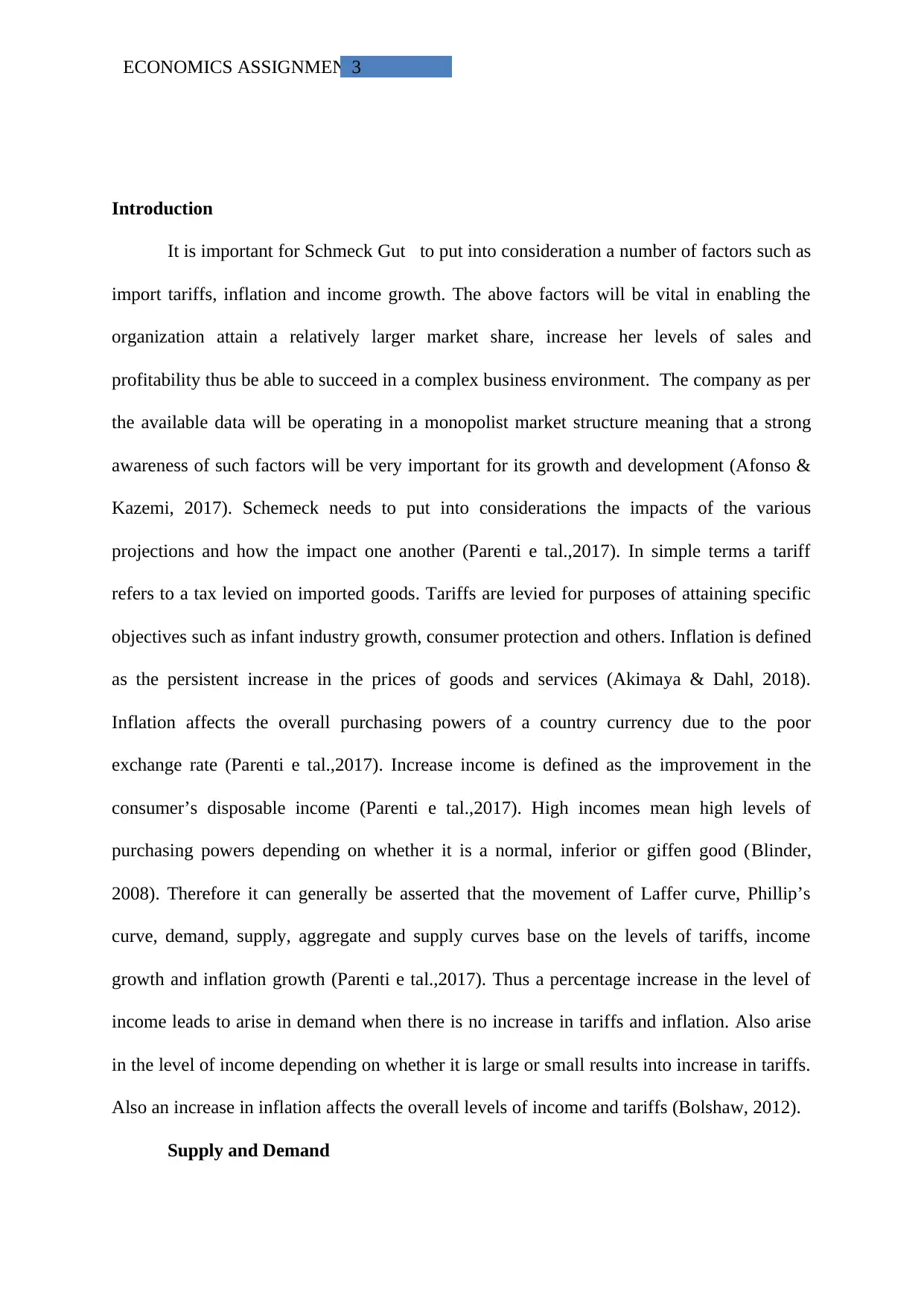
ECONOMICS ASSIGNMENT3
Introduction
It is important for Schmeck Gut to put into consideration a number of factors such as
import tariffs, inflation and income growth. The above factors will be vital in enabling the
organization attain a relatively larger market share, increase her levels of sales and
profitability thus be able to succeed in a complex business environment. The company as per
the available data will be operating in a monopolist market structure meaning that a strong
awareness of such factors will be very important for its growth and development (Afonso &
Kazemi, 2017). Schemeck needs to put into considerations the impacts of the various
projections and how the impact one another (Parenti e tal.,2017). In simple terms a tariff
refers to a tax levied on imported goods. Tariffs are levied for purposes of attaining specific
objectives such as infant industry growth, consumer protection and others. Inflation is defined
as the persistent increase in the prices of goods and services (Akimaya & Dahl, 2018).
Inflation affects the overall purchasing powers of a country currency due to the poor
exchange rate (Parenti e tal.,2017). Increase income is defined as the improvement in the
consumer’s disposable income (Parenti e tal.,2017). High incomes mean high levels of
purchasing powers depending on whether it is a normal, inferior or giffen good (Blinder,
2008). Therefore it can generally be asserted that the movement of Laffer curve, Phillip’s
curve, demand, supply, aggregate and supply curves base on the levels of tariffs, income
growth and inflation growth (Parenti e tal.,2017). Thus a percentage increase in the level of
income leads to arise in demand when there is no increase in tariffs and inflation. Also arise
in the level of income depending on whether it is large or small results into increase in tariffs.
Also an increase in inflation affects the overall levels of income and tariffs (Bolshaw, 2012).
Supply and Demand
Introduction
It is important for Schmeck Gut to put into consideration a number of factors such as
import tariffs, inflation and income growth. The above factors will be vital in enabling the
organization attain a relatively larger market share, increase her levels of sales and
profitability thus be able to succeed in a complex business environment. The company as per
the available data will be operating in a monopolist market structure meaning that a strong
awareness of such factors will be very important for its growth and development (Afonso &
Kazemi, 2017). Schemeck needs to put into considerations the impacts of the various
projections and how the impact one another (Parenti e tal.,2017). In simple terms a tariff
refers to a tax levied on imported goods. Tariffs are levied for purposes of attaining specific
objectives such as infant industry growth, consumer protection and others. Inflation is defined
as the persistent increase in the prices of goods and services (Akimaya & Dahl, 2018).
Inflation affects the overall purchasing powers of a country currency due to the poor
exchange rate (Parenti e tal.,2017). Increase income is defined as the improvement in the
consumer’s disposable income (Parenti e tal.,2017). High incomes mean high levels of
purchasing powers depending on whether it is a normal, inferior or giffen good (Blinder,
2008). Therefore it can generally be asserted that the movement of Laffer curve, Phillip’s
curve, demand, supply, aggregate and supply curves base on the levels of tariffs, income
growth and inflation growth (Parenti e tal.,2017). Thus a percentage increase in the level of
income leads to arise in demand when there is no increase in tariffs and inflation. Also arise
in the level of income depending on whether it is large or small results into increase in tariffs.
Also an increase in inflation affects the overall levels of income and tariffs (Bolshaw, 2012).
Supply and Demand
Paraphrase This Document
Need a fresh take? Get an instant paraphrase of this document with our AI Paraphraser

ECONOMICS ASSIGNMENT4
Arise in income by 5 percent may be accompanied by high levels of demand of a
given product which may result into shortages (Blinder, 2008). Therefore for the company to
effectively supply enough to the market, it is forced to employ more factors of production
like labor and at the same undertake various improvements in incentives such as wages in
order to boost production. Where demand is increased without being accompanied by high
production or supply there will be reduced supply thus raising the prices of the goods and
services (Blinder, 2008). Meaning that an increase in five percent in the levels of incomes
results to a rise in the levels of inflation by two percent (Baumol, 2016). Whereas a ten
percent raise in the level of tariffs results into an increase in the levels of income by five
percent due to raises in imported goods prices. Also, a rise in the levels of tariffs by ten
percent results to a fall in demand of imported products and high demand for locally
produced products (Burke & Abayasekara, 2018).
High tariffs make importation expensive. In other words, domestic importers have to
incur high costs while importing particular goods and services. Also with an increase in the
levels of tariffs, imported products will be expensive for consumers to buy due to high prices
meaning that the overall levels of demand on imported products will be low.
Figure1Demand and supply curve (Coglianese etal., 2017)
Arise in income by 5 percent may be accompanied by high levels of demand of a
given product which may result into shortages (Blinder, 2008). Therefore for the company to
effectively supply enough to the market, it is forced to employ more factors of production
like labor and at the same undertake various improvements in incentives such as wages in
order to boost production. Where demand is increased without being accompanied by high
production or supply there will be reduced supply thus raising the prices of the goods and
services (Blinder, 2008). Meaning that an increase in five percent in the levels of incomes
results to a rise in the levels of inflation by two percent (Baumol, 2016). Whereas a ten
percent raise in the level of tariffs results into an increase in the levels of income by five
percent due to raises in imported goods prices. Also, a rise in the levels of tariffs by ten
percent results to a fall in demand of imported products and high demand for locally
produced products (Burke & Abayasekara, 2018).
High tariffs make importation expensive. In other words, domestic importers have to
incur high costs while importing particular goods and services. Also with an increase in the
levels of tariffs, imported products will be expensive for consumers to buy due to high prices
meaning that the overall levels of demand on imported products will be low.
Figure1Demand and supply curve (Coglianese etal., 2017)

ECONOMICS ASSIGNMENT5
As illustrated in the Diagram above an increase in the tariff rate say by 10 percent
results into increased prices of imported products thus lower levels of demand (Cole e tal.,
2017)
.
Agg dd/Aggss (aggregate demand/ aggregate supply
There exists two kinds of equilibrium, short and long run equilibrium. When there is
no match between prices and wages plus the prevailing economic situation, the short run
arises (Diaz, 2012). The level of equilibrium may not be effectively attained in cases where
there are changes in the prevailing economic conditions given that product prices are not able
to rise quickly to maintain the market stability. Irrespective of the economic conditions,
prices and wages are flexible in the long run period (Parenti e tal.,2017). The total supply and
demand of a particular economy are illustrated by the total supply and demand. Therefore,
when the overall productivity levels increases, there is a right word shift of the aggregate
supply curve leading to high levels of growth in income and lower inflation rate (Dimopoulos
& Sacchetto, 2017).
In this case the aggregate supply curve moves left wards mainly due to higher prices,
high rates of inflation and rising tariffs that lowers importation(Blinder, 2008). Hence forth a
ten percent increase in tariff results into a 5 percent increase in income thus leading to a 2
percent inflation rate due to economic stagnation. A rise in income results into more profits
earned by the organization (Hayn etal., 2018). When there is an increase in the levels of
income, a firm increases her production capacity in order to increase the level of profits. Thus
an increase in the level of tariff by ten percent and income by 5 percent results into a 2
percent inflation rate emanating from the desire by firms to expand the overall level of output
(Jungherr e tal., 2018)
As illustrated in the Diagram above an increase in the tariff rate say by 10 percent
results into increased prices of imported products thus lower levels of demand (Cole e tal.,
2017)
.
Agg dd/Aggss (aggregate demand/ aggregate supply
There exists two kinds of equilibrium, short and long run equilibrium. When there is
no match between prices and wages plus the prevailing economic situation, the short run
arises (Diaz, 2012). The level of equilibrium may not be effectively attained in cases where
there are changes in the prevailing economic conditions given that product prices are not able
to rise quickly to maintain the market stability. Irrespective of the economic conditions,
prices and wages are flexible in the long run period (Parenti e tal.,2017). The total supply and
demand of a particular economy are illustrated by the total supply and demand. Therefore,
when the overall productivity levels increases, there is a right word shift of the aggregate
supply curve leading to high levels of growth in income and lower inflation rate (Dimopoulos
& Sacchetto, 2017).
In this case the aggregate supply curve moves left wards mainly due to higher prices,
high rates of inflation and rising tariffs that lowers importation(Blinder, 2008). Hence forth a
ten percent increase in tariff results into a 5 percent increase in income thus leading to a 2
percent inflation rate due to economic stagnation. A rise in income results into more profits
earned by the organization (Hayn etal., 2018). When there is an increase in the levels of
income, a firm increases her production capacity in order to increase the level of profits. Thus
an increase in the level of tariff by ten percent and income by 5 percent results into a 2
percent inflation rate emanating from the desire by firms to expand the overall level of output
(Jungherr e tal., 2018)
⊘ This is a preview!⊘
Do you want full access?
Subscribe today to unlock all pages.

Trusted by 1+ million students worldwide
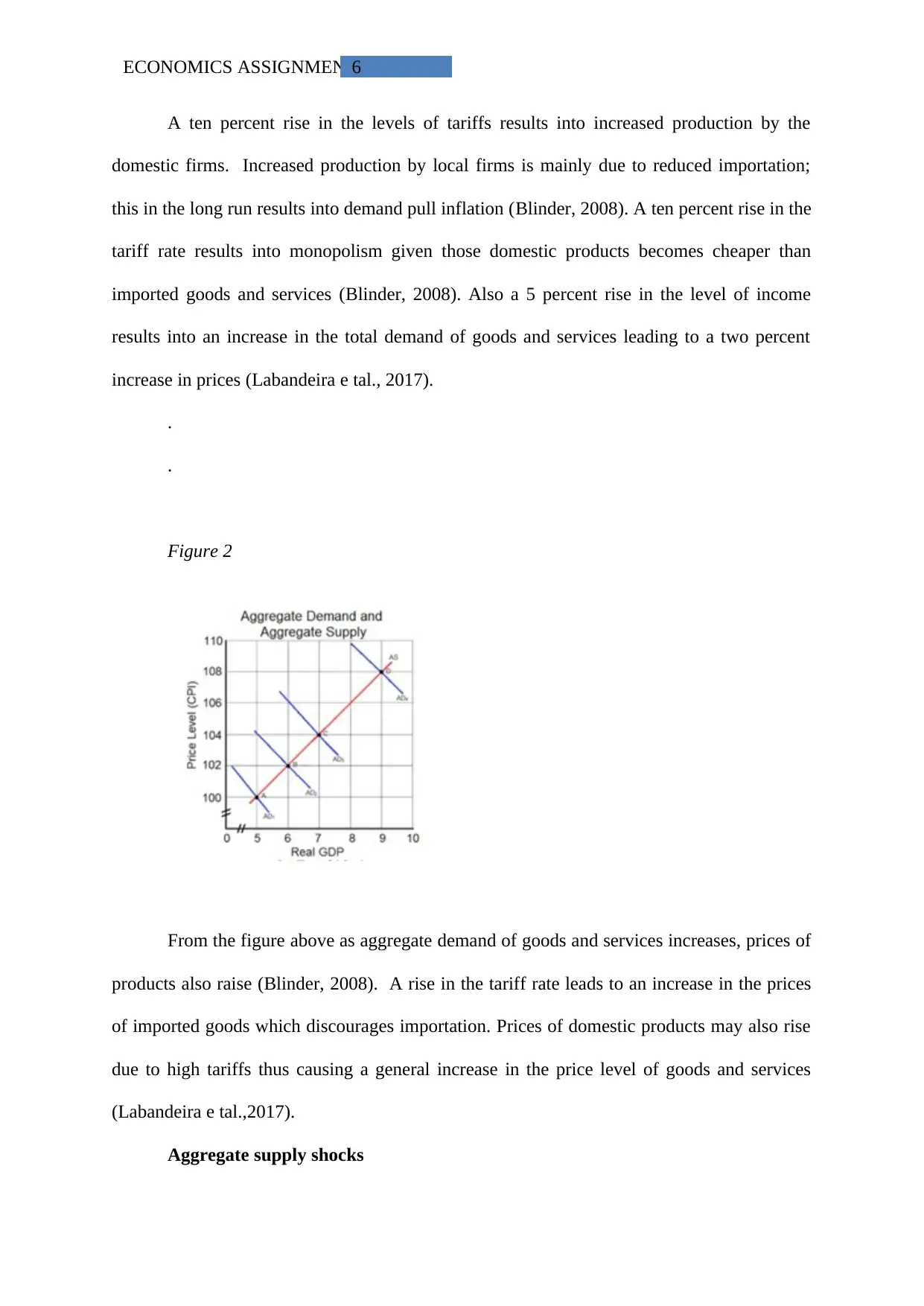
ECONOMICS ASSIGNMENT6
A ten percent rise in the levels of tariffs results into increased production by the
domestic firms. Increased production by local firms is mainly due to reduced importation;
this in the long run results into demand pull inflation (Blinder, 2008). A ten percent rise in the
tariff rate results into monopolism given those domestic products becomes cheaper than
imported goods and services (Blinder, 2008). Also a 5 percent rise in the level of income
results into an increase in the total demand of goods and services leading to a two percent
increase in prices (Labandeira e tal., 2017).
.
.
Figure 2
From the figure above as aggregate demand of goods and services increases, prices of
products also raise (Blinder, 2008). A rise in the tariff rate leads to an increase in the prices
of imported goods which discourages importation. Prices of domestic products may also rise
due to high tariffs thus causing a general increase in the price level of goods and services
(Labandeira e tal.,2017).
Aggregate supply shocks
A ten percent rise in the levels of tariffs results into increased production by the
domestic firms. Increased production by local firms is mainly due to reduced importation;
this in the long run results into demand pull inflation (Blinder, 2008). A ten percent rise in the
tariff rate results into monopolism given those domestic products becomes cheaper than
imported goods and services (Blinder, 2008). Also a 5 percent rise in the level of income
results into an increase in the total demand of goods and services leading to a two percent
increase in prices (Labandeira e tal., 2017).
.
.
Figure 2
From the figure above as aggregate demand of goods and services increases, prices of
products also raise (Blinder, 2008). A rise in the tariff rate leads to an increase in the prices
of imported goods which discourages importation. Prices of domestic products may also rise
due to high tariffs thus causing a general increase in the price level of goods and services
(Labandeira e tal.,2017).
Aggregate supply shocks
Paraphrase This Document
Need a fresh take? Get an instant paraphrase of this document with our AI Paraphraser
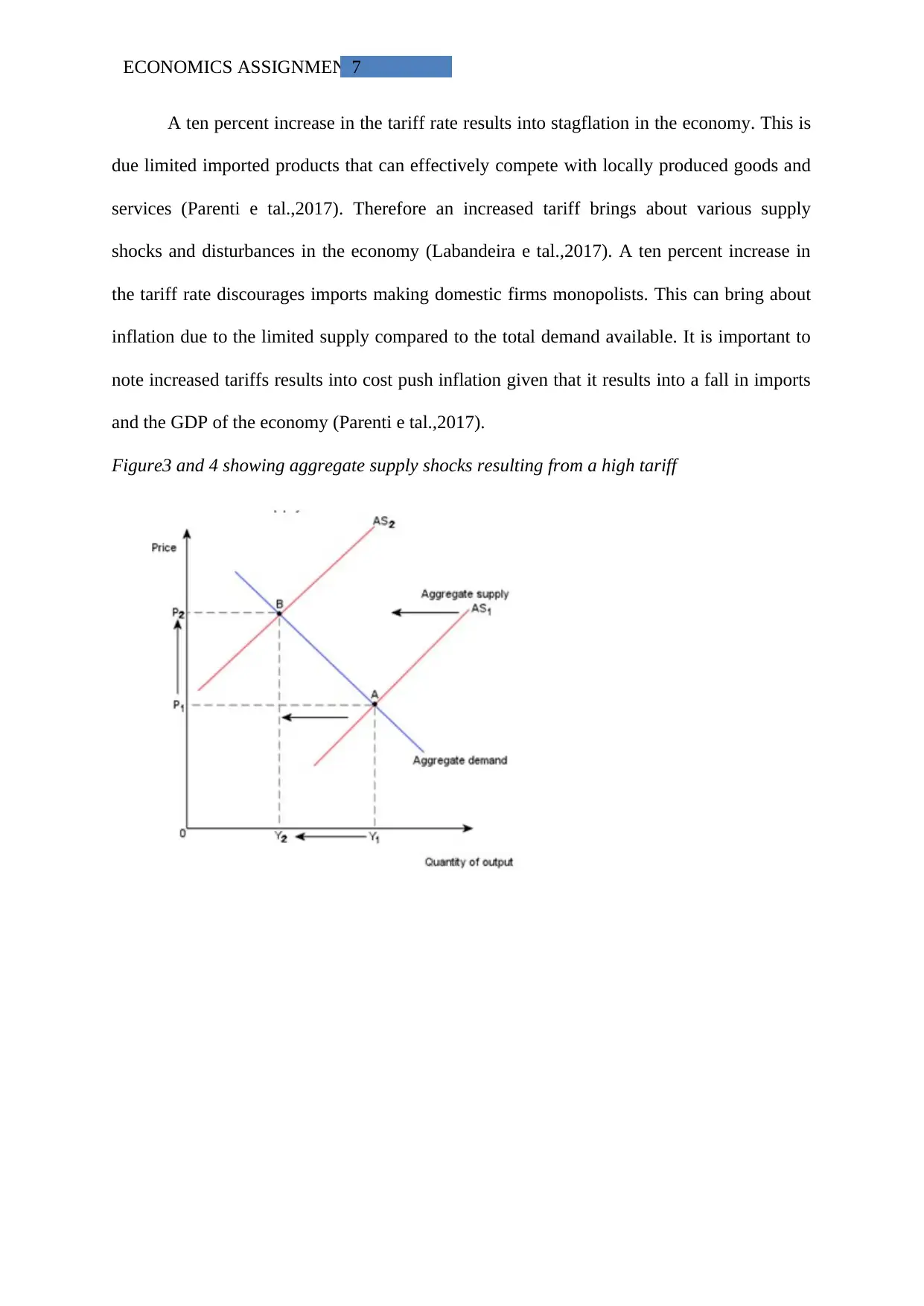
ECONOMICS ASSIGNMENT7
A ten percent increase in the tariff rate results into stagflation in the economy. This is
due limited imported products that can effectively compete with locally produced goods and
services (Parenti e tal.,2017). Therefore an increased tariff brings about various supply
shocks and disturbances in the economy (Labandeira e tal.,2017). A ten percent increase in
the tariff rate discourages imports making domestic firms monopolists. This can bring about
inflation due to the limited supply compared to the total demand available. It is important to
note increased tariffs results into cost push inflation given that it results into a fall in imports
and the GDP of the economy (Parenti e tal.,2017).
Figure3 and 4 showing aggregate supply shocks resulting from a high tariff
A ten percent increase in the tariff rate results into stagflation in the economy. This is
due limited imported products that can effectively compete with locally produced goods and
services (Parenti e tal.,2017). Therefore an increased tariff brings about various supply
shocks and disturbances in the economy (Labandeira e tal.,2017). A ten percent increase in
the tariff rate discourages imports making domestic firms monopolists. This can bring about
inflation due to the limited supply compared to the total demand available. It is important to
note increased tariffs results into cost push inflation given that it results into a fall in imports
and the GDP of the economy (Parenti e tal.,2017).
Figure3 and 4 showing aggregate supply shocks resulting from a high tariff
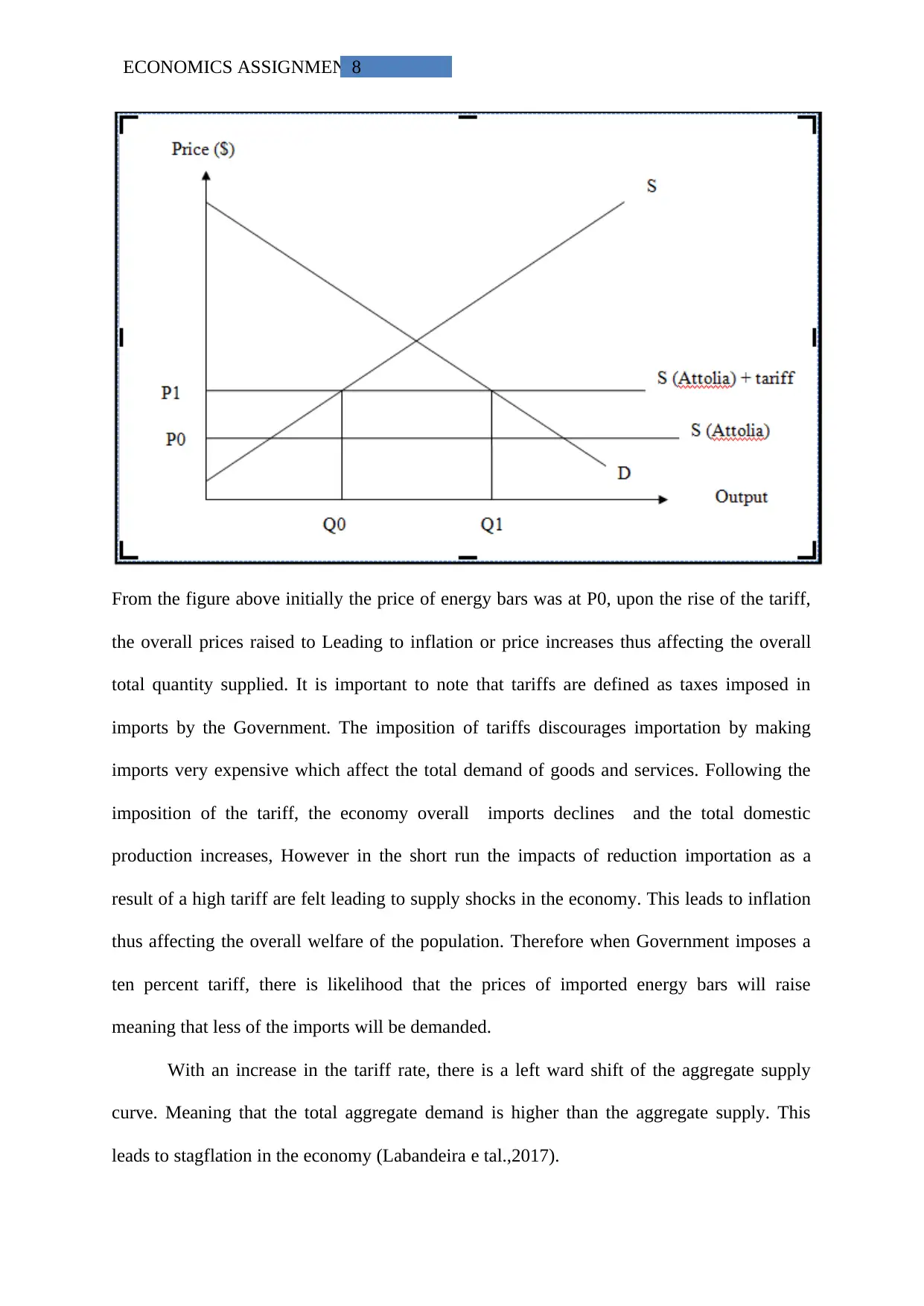
ECONOMICS ASSIGNMENT8
From the figure above initially the price of energy bars was at P0, upon the rise of the tariff,
the overall prices raised to Leading to inflation or price increases thus affecting the overall
total quantity supplied. It is important to note that tariffs are defined as taxes imposed in
imports by the Government. The imposition of tariffs discourages importation by making
imports very expensive which affect the total demand of goods and services. Following the
imposition of the tariff, the economy overall imports declines and the total domestic
production increases, However in the short run the impacts of reduction importation as a
result of a high tariff are felt leading to supply shocks in the economy. This leads to inflation
thus affecting the overall welfare of the population. Therefore when Government imposes a
ten percent tariff, there is likelihood that the prices of imported energy bars will raise
meaning that less of the imports will be demanded.
With an increase in the tariff rate, there is a left ward shift of the aggregate supply
curve. Meaning that the total aggregate demand is higher than the aggregate supply. This
leads to stagflation in the economy (Labandeira e tal.,2017).
From the figure above initially the price of energy bars was at P0, upon the rise of the tariff,
the overall prices raised to Leading to inflation or price increases thus affecting the overall
total quantity supplied. It is important to note that tariffs are defined as taxes imposed in
imports by the Government. The imposition of tariffs discourages importation by making
imports very expensive which affect the total demand of goods and services. Following the
imposition of the tariff, the economy overall imports declines and the total domestic
production increases, However in the short run the impacts of reduction importation as a
result of a high tariff are felt leading to supply shocks in the economy. This leads to inflation
thus affecting the overall welfare of the population. Therefore when Government imposes a
ten percent tariff, there is likelihood that the prices of imported energy bars will raise
meaning that less of the imports will be demanded.
With an increase in the tariff rate, there is a left ward shift of the aggregate supply
curve. Meaning that the total aggregate demand is higher than the aggregate supply. This
leads to stagflation in the economy (Labandeira e tal.,2017).
⊘ This is a preview!⊘
Do you want full access?
Subscribe today to unlock all pages.

Trusted by 1+ million students worldwide
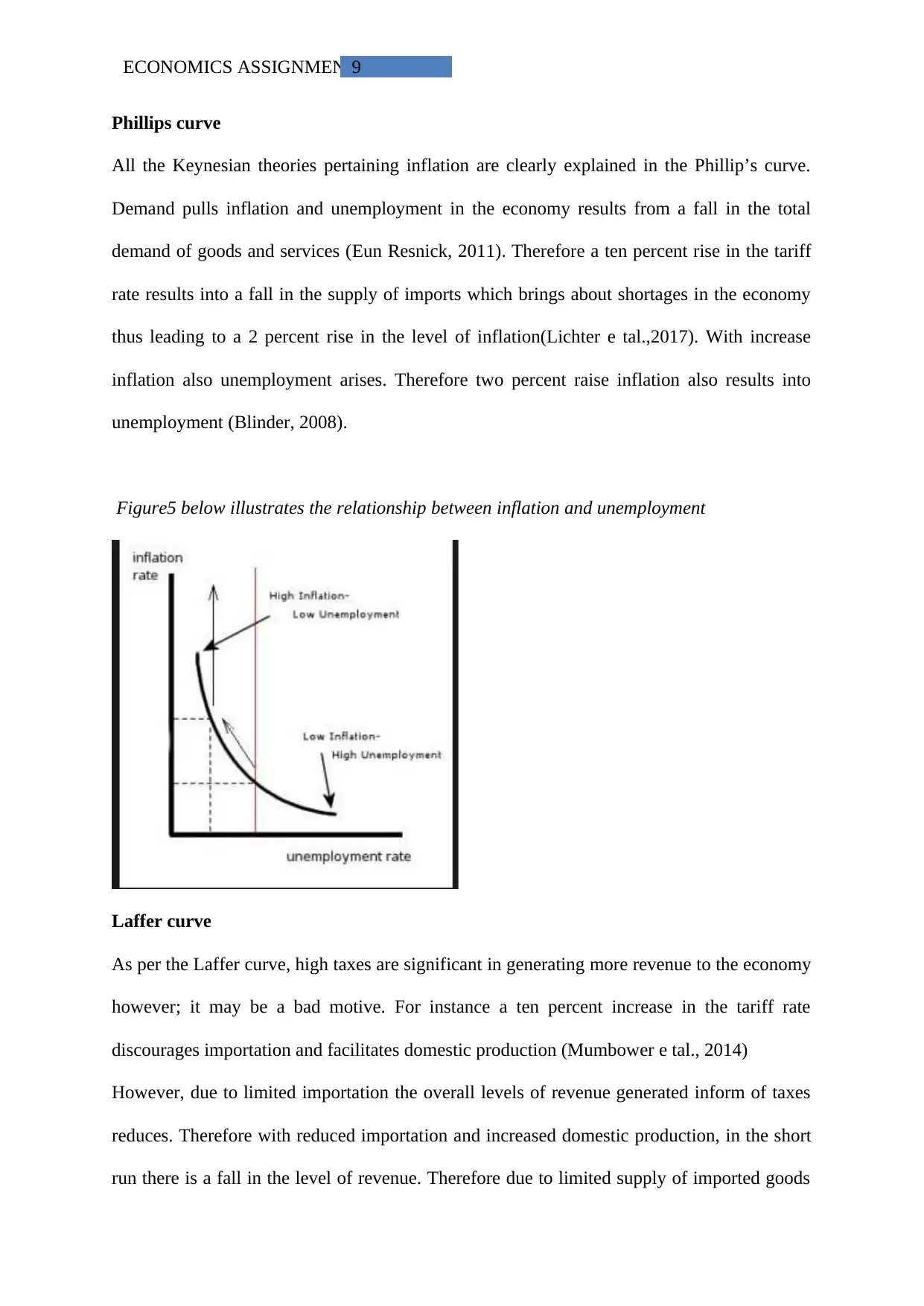
ECONOMICS ASSIGNMENT9
Phillips curve
All the Keynesian theories pertaining inflation are clearly explained in the Phillip’s curve.
Demand pulls inflation and unemployment in the economy results from a fall in the total
demand of goods and services (Eun Resnick, 2011). Therefore a ten percent rise in the tariff
rate results into a fall in the supply of imports which brings about shortages in the economy
thus leading to a 2 percent rise in the level of inflation(Lichter e tal.,2017). With increase
inflation also unemployment arises. Therefore two percent raise inflation also results into
unemployment (Blinder, 2008).
Figure5 below illustrates the relationship between inflation and unemployment
Laffer curve
As per the Laffer curve, high taxes are significant in generating more revenue to the economy
however; it may be a bad motive. For instance a ten percent increase in the tariff rate
discourages importation and facilitates domestic production (Mumbower e tal., 2014)
However, due to limited importation the overall levels of revenue generated inform of taxes
reduces. Therefore with reduced importation and increased domestic production, in the short
run there is a fall in the level of revenue. Therefore due to limited supply of imported goods
Phillips curve
All the Keynesian theories pertaining inflation are clearly explained in the Phillip’s curve.
Demand pulls inflation and unemployment in the economy results from a fall in the total
demand of goods and services (Eun Resnick, 2011). Therefore a ten percent rise in the tariff
rate results into a fall in the supply of imports which brings about shortages in the economy
thus leading to a 2 percent rise in the level of inflation(Lichter e tal.,2017). With increase
inflation also unemployment arises. Therefore two percent raise inflation also results into
unemployment (Blinder, 2008).
Figure5 below illustrates the relationship between inflation and unemployment
Laffer curve
As per the Laffer curve, high taxes are significant in generating more revenue to the economy
however; it may be a bad motive. For instance a ten percent increase in the tariff rate
discourages importation and facilitates domestic production (Mumbower e tal., 2014)
However, due to limited importation the overall levels of revenue generated inform of taxes
reduces. Therefore with reduced importation and increased domestic production, in the short
run there is a fall in the level of revenue. Therefore due to limited supply of imported goods
Paraphrase This Document
Need a fresh take? Get an instant paraphrase of this document with our AI Paraphraser

ECONOMICS ASSIGNMENT10
due to high tariffs, supply shocks emerge in the economy leading to a 2 percent increase in
the level of inflation (Mankiw, 2014).
Figure 6 below explains the effect of a high tariff on price and supply in the economy
Effect on inflation rate, tariff rate, income growth on schmeckt demand
The three variables strong impact the overall demand of schmeckt(Mumbower e tal.,2014.
The impact of changes in the level of incomes on the demand of schemeckt will depend on
the nature of goods being supplied in the bar depending on whether they are necessities,
inferior, luxuries, normal or giffen goods(McConnell, 2009). Therefore for the case of normal
goods an increase in the consumer’s income will result into more quantity of the product
being demanded. In other words the demand of the products will effectively be based on the
nature of the product(Mumbower e tal.,2014). Also for the increase of an inferior good, arise
in the level of income may not necessitate an increased in the demand of a particular product.
Inferior goods are bought more when the consumer’s income is low and less when the
consumer’s income increases. Therefore for an increase in the income for the case of an
inferior good, will results into an increased in the demand of superior products. Therefore for
due to high tariffs, supply shocks emerge in the economy leading to a 2 percent increase in
the level of inflation (Mankiw, 2014).
Figure 6 below explains the effect of a high tariff on price and supply in the economy
Effect on inflation rate, tariff rate, income growth on schmeckt demand
The three variables strong impact the overall demand of schmeckt(Mumbower e tal.,2014.
The impact of changes in the level of incomes on the demand of schemeckt will depend on
the nature of goods being supplied in the bar depending on whether they are necessities,
inferior, luxuries, normal or giffen goods(McConnell, 2009). Therefore for the case of normal
goods an increase in the consumer’s income will result into more quantity of the product
being demanded. In other words the demand of the products will effectively be based on the
nature of the product(Mumbower e tal.,2014). Also for the increase of an inferior good, arise
in the level of income may not necessitate an increased in the demand of a particular product.
Inferior goods are bought more when the consumer’s income is low and less when the
consumer’s income increases. Therefore for an increase in the income for the case of an
inferior good, will results into an increased in the demand of superior products. Therefore for

ECONOMICS ASSIGNMENT11
the case of an inferior good there exists a negative correlation between the consumer’s
income and the demand for a particular commodity. For the case of a normal good, an
increase in the levels of income will not have a much impact in the overall quantity of goods
and services demanded (Zhao e tal.,2018).
The impact of tariffs varies basing on whether it is a high or low tariff (Mumbower e
tal.,2014). With a low tariff there will be lower prices of schemeckt gut produced since they
will be open to competition with imported products. It is important to note that the main
objective of high tariffs is to protect domestic industries but limiting the inflow of imports
from outside countries (Mumbower e tal.,2014). Tariffs impact greatly the overall demand of
goods and services. With a low tariff, there will be reduction on the schemeckt Gut prices
which may affect the overall revenue earned by the bar due to competition from international
producers (Mumbower e tal.,2014). Therefore given that the company will be new in the
market, it will be affected by low tariffs (Parenti e tal.,2017). With high tariffs, the bar will
benefit from increased demand due to limited competitors which results into high levels of
market share, sales and revenues (Free, 2010).
Higher levels of inflation will affect the demand of the bar products and services. It is
important to note as per Keynes understanding of economics, inflation usually arises from
supply side disturbances within the economy (Mumbower e tal.,2014). In other words,
demanding exceeding supply (Mumbower e tal.,2014). Therefore with high levels of tariffs,
the production will be low which will lead to demand pull inflation. Therefore the prices of
the bar products will be high as the prices of goods and services increases which may result
into unemployment so as to cut production costs (Free, 2010). It is important to note that high
levels of inflation forces firms to lay off workers for purposes of reducing the costs of
production (Free, 2010).
Regression analysis
the case of an inferior good there exists a negative correlation between the consumer’s
income and the demand for a particular commodity. For the case of a normal good, an
increase in the levels of income will not have a much impact in the overall quantity of goods
and services demanded (Zhao e tal.,2018).
The impact of tariffs varies basing on whether it is a high or low tariff (Mumbower e
tal.,2014). With a low tariff there will be lower prices of schemeckt gut produced since they
will be open to competition with imported products. It is important to note that the main
objective of high tariffs is to protect domestic industries but limiting the inflow of imports
from outside countries (Mumbower e tal.,2014). Tariffs impact greatly the overall demand of
goods and services. With a low tariff, there will be reduction on the schemeckt Gut prices
which may affect the overall revenue earned by the bar due to competition from international
producers (Mumbower e tal.,2014). Therefore given that the company will be new in the
market, it will be affected by low tariffs (Parenti e tal.,2017). With high tariffs, the bar will
benefit from increased demand due to limited competitors which results into high levels of
market share, sales and revenues (Free, 2010).
Higher levels of inflation will affect the demand of the bar products and services. It is
important to note as per Keynes understanding of economics, inflation usually arises from
supply side disturbances within the economy (Mumbower e tal.,2014). In other words,
demanding exceeding supply (Mumbower e tal.,2014). Therefore with high levels of tariffs,
the production will be low which will lead to demand pull inflation. Therefore the prices of
the bar products will be high as the prices of goods and services increases which may result
into unemployment so as to cut production costs (Free, 2010). It is important to note that high
levels of inflation forces firms to lay off workers for purposes of reducing the costs of
production (Free, 2010).
Regression analysis
⊘ This is a preview!⊘
Do you want full access?
Subscribe today to unlock all pages.

Trusted by 1+ million students worldwide
1 out of 20
Related Documents
Your All-in-One AI-Powered Toolkit for Academic Success.
+13062052269
info@desklib.com
Available 24*7 on WhatsApp / Email
![[object Object]](/_next/static/media/star-bottom.7253800d.svg)
Unlock your academic potential
Copyright © 2020–2026 A2Z Services. All Rights Reserved. Developed and managed by ZUCOL.





